 |
THE CLASSIC REVIVALS IN EUROPE:THE EIGHTEENTH CENTURY |
| << RENAISSANCE ARCHITECTURE IN GERMANY, SPAIN, AND PORTUGAL |
| RECENT ARCHITECTURE IN EUROPE:MODERN CONDITIONS, FRANCE >> |
CHAPTER
XXV.
THE
CLASSIC REVIVALS IN
EUROPE.
BOOKS RECOMMENDED: As before, Fergusson. Also
Chateau, Histoire
et caractères de
l'architecture
en France;
and Lübke, Geschichte
der Architektur.
(For the most
part,
however,
recourse must be had to the
general histories of architecture,
and to
monographs
on special cities or
buildings.)
THE
EIGHTEENTH CENTURY. By the
end of the seventeenth century the
Renaissance,
properly speaking, had run its
course in Europe. The increasing
servility
of
its imitation of antique
models had exhausted its
elasticity and originality.
Taste
rapidly
declined before the growth of the
industrial and commercial spirit in
the
eighteenth
century. The ferment of democracy and the
disquiet of far-reaching
political
changes had begun to preoccupy the
minds of men to the detriment of
the
arts.
By the middle of the eighteenth century,
however, the extravagances of the
Rococo,
Jesuit, and Louis XV. styles had
begun to pall upon the popular
taste. The
creative
spirit was dead, and nothing
seemed more promising as a
corrective for
these
extravagances than a return to classic
models. But the demand was for a
literal
copying
of the arcades and porticos of Rome, to
serve as frontispieces for buildings
in
which
modern requirements should be
accommodated to these antique
exteriors,
instead
of controlling the design. The result
was a manifest gain in the
splendor of
the
streets and squares adorned by
these highly decorative frontispieces,
but at the
expense
of convenience and propriety in the
buildings themselves. While
this
academic
spirit too often sacrificed
logic and originality to an arbitrary
symmetry and
to
the supposed canons of Roman
design, it also, on the other hand,
led to a
stateliness
and dignity in the planning, especially
in the designing of vestibules,
stairs,
and halls, which render many of the
public buildings it produced well
worthy
of
study. The architecture of the Roman
Revival was pompous and
artificial, but
seldom
trivial, and its somewhat
affected grandeur was a
welcome relief from the
dull
extravagance of the styles it
replaced.
THE
GREEK REVIVAL. The
Roman revival was, however,
displaced in England and
Germany
by the Greek Revival, which set in
near the close of the eighteenth
century.
This
was the result of a newly awakened
interest in the long-neglected monuments
of
Attic
art which the discoveries of Stuart and
Revett--sent out in 1732 by the
London
Society
of Dilettanti--had once more
made known to the world. It led to a
veritable
furore
in
England for Greek Doric and Ionic
columns, which were
applied
indiscriminately
to every class of buildings, with utter
disregard of propriety. The
British
taste was at this time at
its lowest ebb, and failed
to perceive the poverty of
Greek
architecture when deprived of its
proper adornments of carving and
sculpture,
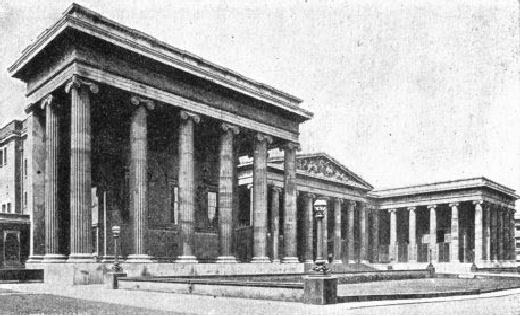
which
were singularly lacking in the
British examples. Nevertheless the
Greek style in
England
had a long run of popular favor,
yielding only during the reign of the
present
sovereign
to the so-called Victorian Gothic, a
revival of mediæval forms. In
Germany
the
Greek Revival was
characterized by a more cultivated
taste and a more
rational
application
of its forms, which were
often freely modified to suit
modern needs. In
France,
where the Roman Revival under
Louis XV. had produced fairly
satisfactory
results,
and where the influence of the Royal
School of Fine Arts
(École
des Beaux-
Arts)
tended to perpetuate the principles of
Roman design, the Greek
Revival found
no
footing. The Greek forms
were seen to be too severe
and intractable for present
requirements.
About 1830, however, a modified
style of design, known since as
the
Néo-Grec,
was introduced by the exertions of a
small coterie of talented
architects;
and
though its own life was
short, it profoundly influenced French
art in the
direction
of freedom and refinement for a long
time afterward. In Italy there
was
hardly
anything in the nature of a true revival
of either Roman or Greek
forms. The
few
important works of the late
eighteenth and early nineteenth
centuries were
conceived
in the spirit of the late Renaissance,
and took from the prevalent revival
of
classicism
elsewhere merely a greater
correctness of detail, not any radical
change of
form
or spirit.
FIG.
198.--BRITISH MUSEUM,
LONDON.
ENGLAND.
There
was, strictly speaking, no
Roman revival in Great
Britain. The
modified
Palladian style of Wren and
Gibbs and their successors continued
until
superseded
by the Greek revival. The first fruit of
the new movement seems to
have
been
the Bank
of England at
London, by Sir
John Soane (1788). In
this edifice the
Greco-Roman
order of the round temple at Tivoli was
closely copied, and applied to
a
long
façade, too low for its
length and with no sufficient stylobate,
but fairly effective
with
its recessed colonnade and
unpierced walls. The British
Museum, by
Robert
Smirke
(Fig.
198), was a more ambitious
essay in a more purely Greek
style. Its
colossal
Ionic colonnade was, however, a
mere frontispiece, applied to a
badly
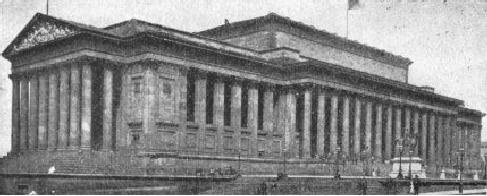
planned
and commonplace building, from which it cut off
needed light. The
more
modest
but appropriate columnar façade to the
Fitzwilliam
Museum at
Cambridge,
by
Bassevi,
was a more successful
attempt in the same direction,
better proportioned
and
avoiding the incongruity of modern
windows in several stories. These
have
always
been the stumbling-block of the revived
Greek style. The difficulties they
raise
are
avoided, however, in buildings
presenting but two stories, the order
being
applied
to the upper story, upon a high stylobate
serving as a basement. The High
School
and the
Royal Institution at Edinburgh, and the
University at London, by
Wilkins,
are for this reason, if for no other,
superior to the British Museum and
other
many-storied
Anglo-Greek edifices. In spite of all
difficulties, however, the
English
extended
the applications of the style with doubtful
success not only to all manner of
public
buildings, but also to country
residences. Carlton House,
Bowden Park, and
Grange
House are instances of this
misapplication of Greek forms.
Neither did it
prove
more tractable for ecclesiastical
purposes. St.
Pancras's Church
at London, and
several
churches by Thomson
(181775),
in Glasgow, though interesting as
experiments
in such adaptation, are not to be
commended for imitation. The
most
successful
of all British Greek designs is
perhaps St.
George's Hall at
Liverpool (Fig.
199),
whose imposing peristyle and
porches are sufficiently
Greek in spirit and
detail
to
class it among the works of the
Greek Revival. But its great
hall and its interior
composition
are really Roman and not
Greek, emphasizing the teaching of
experience
that
Greek architecture does not
lend itself to the exigencies of
modern civilization to
nearly
the same extent as the
Roman.
FIG.
199.--ST. GEORGE'S HALL,
LIVERPOOL.
GERMANY.
During the
eighteenth century the classic
revival in Germany, which at
first
followed Roman precedents
(as in the columns carved with
spirally ascending
reliefs
in front of the church of St.
Charles Borromeo, at
Vienna), was directed
into
the
channel of Greek imitation by the
literary works of Winckelmann,
Lessing,
Goethe,
and others, as well as by the interest
aroused by the discoveries of
Stuart
and
Revett. The Brandenburg
Gate at
Berlin (1784, by Langhans) was an
early
example
of this Hellenism in architecture, and
one of its most successful
applications
to
civic purposes. Without precisely
copying any Greek structure, it
was evidently
inspired
from the Athenian Propylæa, and nothing
in its purpose is foreign to
the
style
employed. The greatest activity in the
style came later, however,
and was
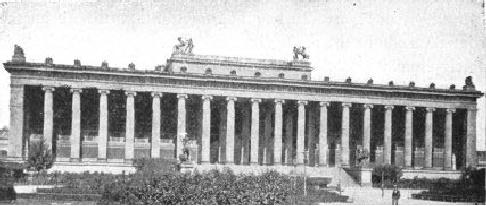
greatly
stimulated by the achievements of
Fr.
Schinkel (17711841),
one of the
greatest
of modern German architects.
While in the domical church of St.
Nicholas at
Potsdam,
he employed Roman forms in a
modernized Roman conception,
and
followed
in one or two other buildings the
principles of the Renaissance,
his
predilections
were for Greek architecture. His
masterpiece was the Museum
at
Berlin,
with an imposing portico of 18 Ionic
columns (Fig. 200). This
building with
its
fine rotunda was excellently
planned, and forms, in conjunction with
the New
Museum
by
Stuhler
(184355),
a noble palace of art, to whose
monumental
requirements
and artistic purpose the Greek
colonnades and pediments were
not
inappropriate.
Schinkel's greatest successor
was Leo
von Klenze (17841864),
whose
more
textual reproductions of Greek
models won him great favor and
wide
employment.
The Walhalla
near
Ratisbon is a modernized Parthenon,
internally
vaulted
with glass; elegant externally, but
too obvious a plagiarism to be
greatly
admired.
The Ruhmeshalle
at Munich, a
double L partly enclosing a colossal
statue
of
Bavaria, and devoted to the commemoration
of Bavaria's great men, is copied
from
no
Greek building, though purely Greek in
design and correct to the smallest
detail.
In
the Glyptothek
(Sculpture
Gallery), in the same city, the one
distinctively Greek
feature
introduced by Klenze, an Ionic portico,
is also the one inappropriate
note in
the
design. The Propylæa
at Munich, by
the same (Fig. 201), and the Court
Theatre
at
Berlin, by Schinkel, are
other important examples of the
style. The latter is
externally
one of the most beautiful
theatres in Europe, though less
ornate than
many.
Schinkel's genius was here
remarkably successful in adapting
Greek details to
the
exigent difficulties of theatre
design, and there is no suggestion of
copying any
known
Greek building.
FIG.
200.--THE OLD MUSEUM,
BERLIN.
In
Vienna the one
notable monument of the
Classic Revival is
the
Reichsrathsgebäude
or
Parliament House, by Th.
Hansen (1843), an
imposing two-
storied
composition with a lofty central
colonnade and lower side-wings,
harmonious
in
general proportions and pleasingly
varied in outline and
mass.
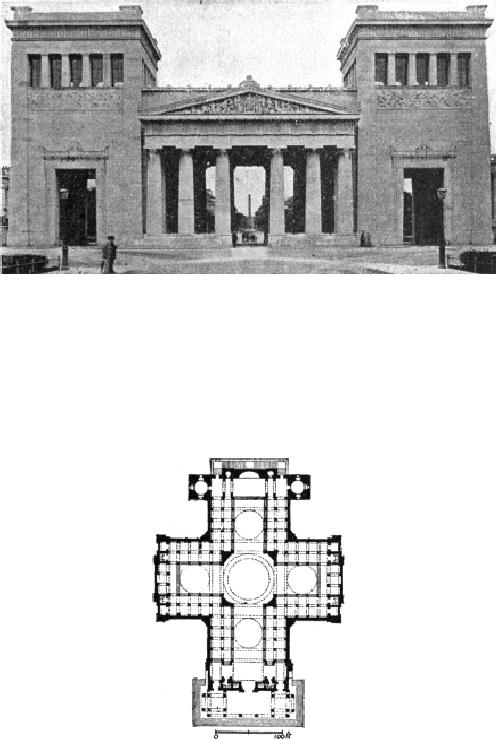
FIG.
201.--THE PROPYLÆA,
MUNICH.
In
general, the Greek Revival in
Germany presents the aspect of a
sincere striving
after
beauty, on the part of a limited number of
artists of great talent,
misled by the
idea
that the forms of a dead civilization
could be galvanized into new life in
the
service
of modern needs. The result
was disappointing, in spite of the
excellent
planning,
admirable construction and carefully
studied detail of these
buildings, and
the
movement here as elsewhere
was foredoomed to
failure.
FIG.
202.--PLAN OF PANTHÉON,
PARIS.
FRANCE.
In
France the Classic Revival, as we
have seen, had made its
appearance
during
the reign of Louis XV. in a number of
important monuments which
expressed
the
protest of their authors against the
caprice of the Rococo style then in
vogue. The
colonnades
of the Garde-Meuble, the façade of St.
Sulpice, and the coldly
beautiful
Panthéon
(Figs.
202, 203) testified to the conviction in the
most cultured minds
of
the
time that Roman grandeur was
to be attained only by copying the forms
of
Roman
architecture with the closest possible
approach to correctness. In the
Panthéon,
the greatest ecclesiastical monument of
its time in France
(otherwise
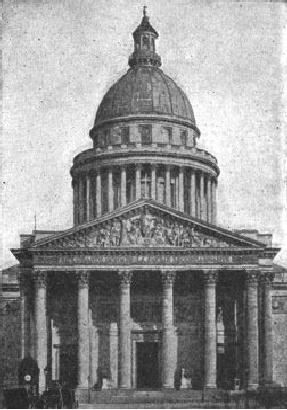
known
as the church of Ste. Genéviève), the
spirit of correct classicism
dominates the
interior
as well as the exterior. It is a Greek
cross, measuring 362 × 267 feet, with
a
dome
265 feet high, and internally 69
feet in diameter. The four arms
have domical
vaulting
and narrow aisles separated by Corinthian
columns. The whole interior is a
cold
but extremely elegant composition. The
most notable features of the
exterior are
its
imposing portico of colossal
Corinthian columns and the fine
peristyle which
surrounds
the drum of the dome, giving it great
dignity and richness of
effect.
FIG.
203.--EXTERIOR OF PANTHÉON,
PARIS.
The
dome, which is of stone throughout,
has three shells, the
intermediate shell
serving
to support the heavy stone
lantern. The architect was
Soufflot
(171381).
The
Grand
Théâtre, at
Bordeaux (1773, by Victor
Louis),
one of the largest and
finest
theatres in Europe, was
another product of this movement,
its stately
colonnade
forming one of the chief
ornaments of the city. Under Louis XVI.
there
was
a temporary reaction from this somewhat
pompous affectation of
antique
grandeur;
but there were few important
buildings erected during that unhappy
reign,
and
the reaction showed itself mainly in a
more delicate and graceful
style of interior
decoration.
It was reserved for the Empire to
set the seal of official
approval on the
Roman
Revival.
The
Arch of Triumph of the Carrousel, behind the
Tuileries, by Percier
and Fontaine,
the
magnificent Arc de l'Étoile, at the
summit of the Avenue of the Champs
Elysées,
by
Chalgrin; the wing
begun by Napoleon to connect the
Tuileries with the Louvre on
the
land side, and the church of the Madeleine, by
Vignon,
erected as a temple to the
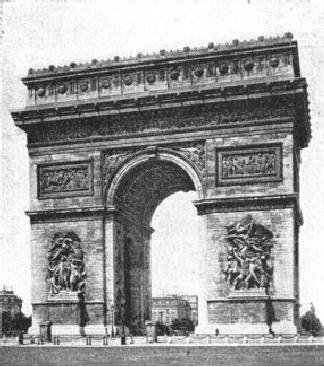
heroes
of the Grande Armée, were all
designed, in accordance with the
expressed will
of
the Emperor himself, in a style as
Roman as the requirements of each
case would
permit.
All these monuments, begun
between 1806 and 1809, were completed
after
the
Restoration. The Arch
of the
Carrousel
is a
close copy of Roman models;
that of
the
Étoile
(Fig.
204) was a much more original
design, of colossal dimensions.
Its
admirable
proportions, simple composition and
striking sculptures give it a
place
among
the noblest creations of its
class. The Madeleine
(Fig.
205), externally a
Roman
Corinthian temple of the largest
size, presents internally an
almost Byzantine
conception
with the three pendentive domes that
vault its vast nave, but all
the
details
are Roman. However suitable
for a pantheon or mausoleum, it
seems
strangely
inappropriate as a design for a Christian
church. To these monuments
should
be added the Bourse
or
Exchange, by Brongniart,
heavy in spite of its
Corinthian
peristyle, and the river front of the
Corps
Législatif or
Palais Bourbon, by
Poyet, the only
extant example of a dodecastyle
portico with a pediment. All of
these
designs
are characterized by great
elegance of detail and excellence of
execution, and
however
inappropriate in style to modern
uses, they add immensely to the
splendor
of
the French capital. Unquestionably no
feature can take the place
of a Greek or
Roman
colonnade as an embellishment for broad
avenues and open squares, or as
the
termination
of an architectural vista.
FIG.
204.--ARC DE L'ÉTOILE,
PARIS.
The
Greek revival took little hold of the
Parisian imagination. Its forms
were too
cold,
too precise and fixed, too
intractable to modern requirements to
appeal to the
French
taste. It counts but one
notable monument, the church of St.
Vincent de
Paul, by
Hittorff, who
sought to apply to this design the
principles of Greek
external
polychromy;
but the frescoes and ornaments failed to
withstand the Parisian
climate,
and
were finally erased. The Néo-Grec
movement already referred to,
initiated by
Duc,
Duban, and Labrouste about 1830, aimed
only to introduce into modern
design
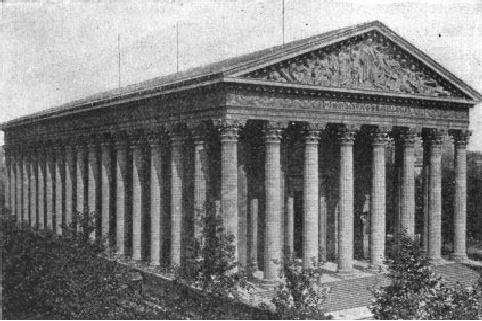
the
spirit and refinement, the purity and
delicacy of Greek art, not its
forms (Fig.
206).
Its chief monuments were the
remodelling, by Duc, of the
Palais
de Justice,
of
which
the new west façade is the most
striking single feature; the
beautiful Library
of
the École des Beaux-Arts, by
Duban; the
library of Ste.
Genéviève, by
Labrouste,
in
which a long façade is treated without a
pilaster or column, simple arches
over a
massive
basement forming the dominant
motive, while in the interior a system
of
iron
construction with glazed domes
controls the design; and the
commemorative
Colonne
Juillet, by Duc, the
most elegant and appropriate of all
modern memorial
columns.
All these buildings, begun
between 1830 and 1850 and completed
at
various
dates, are distinguished by a
remarkable purity and freedom of
conception
and
detail, quite unfettered by the
artificial trammels of the official
academic style
then
prevalent.
FIG.
205.--THE MADELEINE,
PARIS.
THE
CLASSIC REVIVAL ELSEWHERE.
The
other countries of Europe
have little to
show
in the way of imitations of classic
monuments or reproductions of
Roman
colonnades.
In Italy the church of S.
Francesco di Paola, at
Naples, in quasi-
imitation
of the Pantheon at Rome, with
wing-colonnades, and the Superga, at
Turin
(1706,
by Ivara); the
façade of the San Carlo
Theatre, at Naples, and the
Braccio
Nuovo
of the Vatican (1817, by Stern)
are the monuments which come the
nearest to
the
spirit and style of the Roman
Revival. Yet in each of these
there is a large
element
of originality and freedom of treatment
which renders doubtful their
classification
as examples of that movement.
A
reflection of the Munich school is seen
in the modern public buildings of
Athens,
designed
in some cases by German
architects, and in others by native
Greeks. The
University,
the Museum buildings, the Academy of Art and
Science, and other
edifices
exemplify fairly successful efforts to
adapt the severe details of
classic Greek
art
to modern windowed structures. They
suffer somewhat from the too
liberal use of
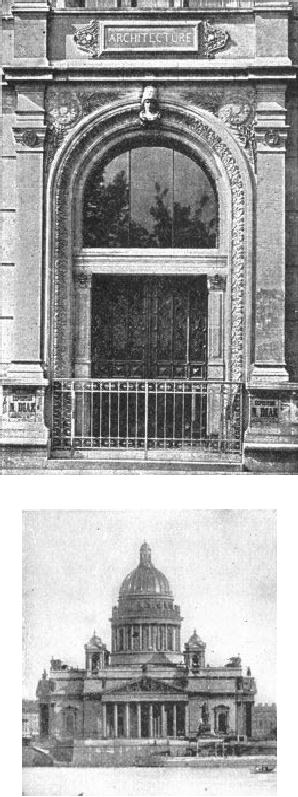
stucco
in place of marble, and from the
conscious affectation of an extinct
style. But
they
are for the most part pleasing and
monumental designs, adding
greatly to the
beauty
of the modern city.
FIG.
206.--DOORWAY, ÉCOLE DES BEAUX-ARTS,
PARIS.
FIG.
207.--ST. ISAAC'S CATHEDRAL,
ST. PETERSBURG.
In
Russia, during and after the
reign of Peter the Great (16891725),
there appeared
a
curious mixture of styles. A style
analogous to the Jesuit in Italy and
the
Churrigueresque
in Spain was generally
prevalent, but it was in many cases
modified
by
Muscovite traditions into nondescript
forms like those of the
Kremlin, at
Moscow,
or
the less extravagant Citadel
Church and Smolnoy Monastery at
St. Petersburg.
Along
with this heavy and barbarous style,
which prevails generally in the
numerous
palaces
of the capital, finished in stucco with
atrocious details, a more
severe and
classical
spirit is met with. The church of the Greek
Rite at
St. Petersburg
combines
a
Roman domical interior with an
exterior of the Greek Doric
order. The Church of
Our
Lady of Kazan has
a semicircular colonnade projecting from
its transept,
copying
as nearly as may be the colonnades in front of
St. Peter's. But the
greatest
classic
monument in Russia is the Cathedral
of St. Isaac (Fig.
207), at St.
Petersburg,
a vast rectangular edifice with four
Roman Corinthian
pedimental
colonnades
projecting from its faces, and a
dome with a peristyle crowning
the
whole.
Despite many defects of detail, and the
use of cast iron for the dome,
which
pretends
to be of marble, this is one of the most
impressive churches of its
size in
Europe.
Internally it displays the costliest
materials in extraordinary profusion,
while
externally
its noble colonnades go far to
redeem its bare attic and
the material of its
dome.
The Palace
of the Grand Duke
Michael, which
reproduces, with
improvements,
Gabriel's colonnades of the Garde
Meuble at Paris on its
garden
front,
is a nobly planned and commendable
design, agreeably contrasting with
the
debased
architecture of many of the public
buildings of the city. The Admiralty
with
its
Doric pilasters, and the New
Museum, by von
Klenze of Munich, in a skilfully
modified
Greek style, with effective
loggias, are the only other
monuments of the
classic
revival in Russia which can find
mention in a brief sketch
like this. Both
are
notable
and in many respects admirable buildings,
in part redeeming the vulgarity
which
is unfortunately so prevalent in the
architecture of St.
Petersburg.
The
MONUMENTS
of the
Classic Revival have been
referred to in the foregoing text
at
sufficient length to preclude the
necessity of further enumeration
here.
Table of Contents:
- PRIMITIVE AND PREHISTORIC ARCHITECTURE:EARLY BEGINNINGS
- EGYPTIAN ARCHITECTURE:LAND AND PEOPLE, THE MIDDLE EMPIRE
- EGYPTIAN ARCHITECTURE—Continued:TEMPLES, CAPITALS
- CHALDÆAN AND ASSYRIAN ARCHITECTURE:ORNAMENT, MONUMENTS
- PERSIAN, LYCIAN AND JEWISH ARCHITECTURE:Jehovah
- GREEK ARCHITECTURE:GENERAL CONSIDERATIONS, THE DORIC
- GREEK ARCHITECTURE—Continued:ARCHAIC PERIOD, THE TRANSITION
- ROMAN ARCHITECTURE:LAND AND PEOPLE, GREEK INFLUENCE
- ROMAN ARCHITECTURE—Continued:IMPERIAL ARCHITECTURE
- EARLY CHRISTIAN ARCHITECTURE:INTRODUCTORY, RAVENNA
- BYZANTINE ARCHITECTURE:DOMES, DECORATION, CARVED DETAILS
- SASSANIAN AND MOHAMMEDAN ARCHITECTURE:ARABIC ARCHITECTURE
- EARLY MEDIÆVAL ARCHITECTURE:LOMBARD STYLE, FLORENCE
- EARLY MEDIÆVAL ARCHITECTURE.—Continued:EARLY CHURCHES, GREAT BRITAIN
- GOTHIC ARCHITECTURE:STRUCTURAL PRINCIPLES, RIBBED VAULTING
- GOTHIC ARCHITECTURE IN FRANCE:STRUCTURAL DEVELOPMENT
- GOTHIC ARCHITECTURE IN GREAT BRITAIN:GENERAL CHARACTER
- GOTHIC ARCHITECTURE IN GERMANY, THE NETHERLANDS, AND SPAIN
- GOTHIC ARCHITECTURE IN ITALY:CLIMATE AND TRADITION, EARLY BUILDINGS.
- EARLY RENAISSANCE ARCHITECTURE IN ITALY:THE CLASSIC REVIVAL, PERIODS
- RENAISSANCE ARCHITECTURE IN ITALY—Continued:BRAMANTE’S WORKS
- RENAISSANCE ARCHITECTURE IN FRANCE:THE TRANSITION, CHURCHES
- RENAISSANCE ARCHITECTURE IN GREAT BRITAIN AND THE NETHERLANDS
- RENAISSANCE ARCHITECTURE IN GERMANY, SPAIN, AND PORTUGAL
- THE CLASSIC REVIVALS IN EUROPE:THE EIGHTEENTH CENTURY
- RECENT ARCHITECTURE IN EUROPE:MODERN CONDITIONS, FRANCE
- ARCHITECTURE IN THE UNITED STATES:GENERAL REMARKS, DWELLINGS
- ORIENTAL ARCHITECTURE:INTRODUCTORY NOTE, CHINESE ARCHITECTURE
- APPENDIX.